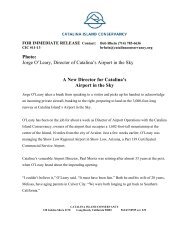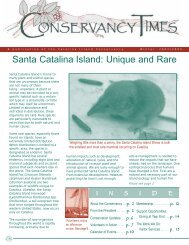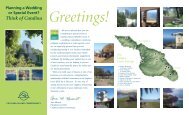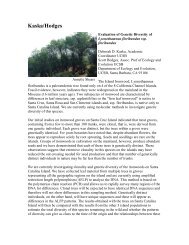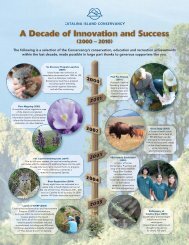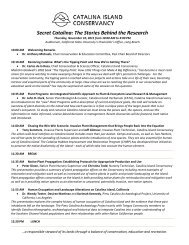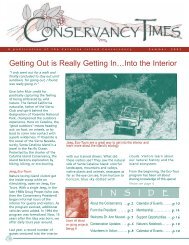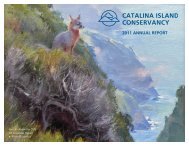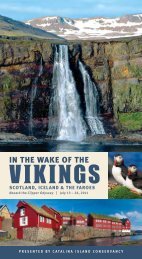Island in the Sea - Catalina Island Conservancy
Island in the Sea - Catalina Island Conservancy
Island in the Sea - Catalina Island Conservancy
Create successful ePaper yourself
Turn your PDF publications into a flip-book with our unique Google optimized e-Paper software.
<strong>Island</strong> <strong>in</strong> <strong>the</strong> <strong>Sea</strong>cont<strong>in</strong>ued from page 1common to Catal<strong>in</strong>a. To accomplish this often daunt<strong>in</strong>gtask, <strong>the</strong> scientific research divers have loggedthousands of hours underwater. Key SpeciesMonitor<strong>in</strong>g takes place at seven sites around <strong>the</strong> island:Cactus Bay, near <strong>the</strong> northwest corner of Catal<strong>in</strong>a. Thisgeneral area is one of <strong>the</strong> most diverse and perhapsmost important underwater areas on <strong>the</strong> <strong>Island</strong>. It was<strong>the</strong> last area to be impacted by <strong>the</strong> El N<strong>in</strong>o conditionsof a few years ago and <strong>the</strong> first tocome back as <strong>the</strong> conditionssubsided. Team leader, JohnUlrich, has been lead<strong>in</strong>g divers tothis site for <strong>the</strong> past several years.Little Harbor. Accord<strong>in</strong>g to leaderRobert Newman, current CCD VicePresident, "This is probably <strong>the</strong>toughest site we monitor as thisarea is constantly pounded by <strong>the</strong>nor<strong>the</strong>rn cold water swell.”Church Rock. At <strong>the</strong> sou<strong>the</strong>rnmost end of <strong>the</strong> <strong>Island</strong>, ChurchRock is frequently plagued bypoor visibility due to prevail<strong>in</strong>gcurrents. All of <strong>the</strong> Key SpeciesMonitor<strong>in</strong>g sites on <strong>the</strong> w<strong>in</strong>dwardside of <strong>the</strong> <strong>Island</strong> are surveyedannually, whereas <strong>the</strong> sites on <strong>the</strong>lee side are surveyed quarterly.Avalon, besides be<strong>in</strong>g ano<strong>the</strong>r KeySpecies Monitor<strong>in</strong>g site, is also <strong>the</strong>location of <strong>the</strong> SCUBA Trail designed to teachrecreational divers about <strong>the</strong> species <strong>the</strong>y see whendiv<strong>in</strong>g at Catal<strong>in</strong>a. The trail is periodically set up byGreg Heilig. Jeff Buchman, Ted Sharshan, and MikeDoran are site leaders <strong>in</strong> Avalon.Italian Gardens. C<strong>in</strong>dy Lipthay currently leads <strong>the</strong> diversat this site. It is a great div<strong>in</strong>g area and often providesopportunities to see Black <strong>Sea</strong> Bass. These magnificentand amaz<strong>in</strong>gly curious fish, which were almostelim<strong>in</strong>ated, have made a very encourag<strong>in</strong>g comebackafter be<strong>in</strong>g declared a protected species.Steven G. BenavidesCatal<strong>in</strong>a <strong>Conservancy</strong> Diver memberconduct<strong>in</strong>g research <strong>in</strong> one of <strong>the</strong>many kelp forests around Catal<strong>in</strong>a.Mar<strong>in</strong>e Reserve, located around <strong>the</strong> Wrigley Institutefor Environmental Studies. The current reserve stretchesfrom Blue Cavern Po<strong>in</strong>t, just south of Bird Rock, along<strong>the</strong> coastl<strong>in</strong>e toward Two Harbors. Fish<strong>in</strong>g andanchor<strong>in</strong>g are restricted from this area, and it is a notakezone. The reserve is only one of two that currentlyexist <strong>in</strong> California. It is a major research site for CCD.Bruce Cook oversees Pumpernickel Cove, just around<strong>the</strong> corner from Blue Cavern Po<strong>in</strong>t. Also <strong>in</strong> <strong>the</strong> reserve,CCD's Kelp Forest Monitor<strong>in</strong>g Project, directed by JohnTurney, has been monitor<strong>in</strong>g kelp growth and densities<strong>in</strong> <strong>the</strong> reserve s<strong>in</strong>ce 1992. In <strong>the</strong> last El N<strong>in</strong>o, <strong>the</strong>reserve's kelp forest became a desert as <strong>the</strong> warm waterdepleted <strong>the</strong> nutrients neededby <strong>the</strong> kelp.Eagle Reef. JP Pylkkanen leadsthis Key Species Monitor<strong>in</strong>g site.Probably <strong>the</strong> most heavily divedof all of our research sites, it is acommon stop for <strong>the</strong>commercial dive boats. Here, asat all of our research sites, wema<strong>in</strong>ta<strong>in</strong> <strong>the</strong>rmographs. These<strong>in</strong>struments record watertemperature on an hourly basis.They are retrieved andcalibrated periodically by CCDresearch divers so <strong>the</strong> data canbe stored and analyzed.With research sites scattered atall corners of Catal<strong>in</strong>a, one of<strong>the</strong> challenges of <strong>the</strong> Catal<strong>in</strong>a<strong>Conservancy</strong> Divers is gett<strong>in</strong>gout to <strong>the</strong> locations. We havebeen helped tremendously by<strong>the</strong> Catal<strong>in</strong>a Mar<strong>in</strong>eros, ano<strong>the</strong>rsupport group of <strong>the</strong> <strong>Conservancy</strong>, whose membershave provided <strong>the</strong>ir boats to transport divers. (Ed. note:please see page 9 for more <strong>in</strong>formation about <strong>the</strong>Catal<strong>in</strong>a Mar<strong>in</strong>eros.)If you would like tolearn more about<strong>the</strong> Catal<strong>in</strong>a<strong>Conservancy</strong> Diversand our projects,please visit ourwebsite atwww.ccd.org.Larry R. ThompsonGaribaldi, <strong>the</strong> California State Mar<strong>in</strong>e Fish.- Tom Turney,President, Catal<strong>in</strong>a <strong>Conservancy</strong> Divers<strong>Conservancy</strong> Times3





